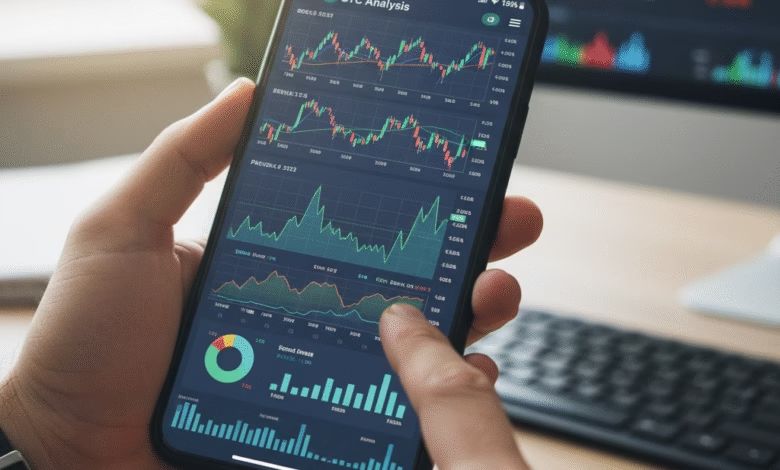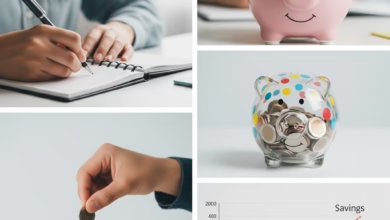How to Build a Diversified Portfolio with Vanguard ETFs
Learn how to create a diversified portfolio with ETFs from Vanguard

If you’re new to investing, the entire concept can feel overwhelming. Wall Street jargon, complex charts, and the 24/7 “breaking news” cycle make it seem like you need a finance degree just to get started. Many people are so intimidated they make the worst choice of all: doing nothing.
But what if there was a proven, simple, and low-cost way to build wealth, one that doesn’t require you to pick the “next hot stock” or time the market?
There is. It’s an investing philosophy pioneered by one of the industry’s greatest legends, John C. Bogle, the founder of Vanguard. The strategy is simple: instead of trying to beat the market, you just buy the market. All of it.
And the easiest, cheapest, and most efficient way to do that is with Vanguard ETFs (Exchange-Traded Funds).
This guide will strip away the jargon and show you, step-by-step, how to use a few simple Vanguard ETFs to build a powerful, globally diversified portfolio designed for long-term growth.
Why Choose Vanguard for Your ETF Portfolio?

Before we get to the “how,” let’s start with the “why.” You see dozens of ads from Fidelity, Schwab, E*TRADE, and Robinhood. What makes Vanguard so special?
It comes down to one fundamental difference: their ownership structure.
Vanguard is not a publicly traded company. It doesn’t have outside stockholders demanding higher profits. Instead, Vanguard is client-owned. The people who own Vanguard’s funds—that means you, the investor—are the owners of the company.
This isn’t just a marketing gimmick. It’s the entire business model.
Because Vanguard doesn’t need to maximize profits for outside shareholders, it can pass those profits back to its investors (its owners) in the form of rock-bottom fees.
This relentless focus on low cost, championed by founder John Bogle, created “the Vanguard effect.” When Vanguard entered a new market with a low-cost fund, all competitors (like Fidelity and Schwab) were forced to lower their own fees to compete. Vanguard has single-handedly saved American investors billions of dollars.
For a long-term retirement investor, fees are your single greatest enemy. A 1% fee might sound small, but over 40 years, it can devour more than a quarter of your potential nest egg. By choosing Vanguard, you are aligning yourself with a company whose primary goal is the same as yours: to keep your costs as low as humanly possible.
What Is an ETF? The “Shopping Cart” of Investing
Before we build a portfolio, let’s understand our main tool.
An Exchange-Traded Fund (ETF) is simply a basket, or a shopping cart, that holds hundreds or even thousands of different investments (like stocks or bonds) inside a single wrapper.
- When you buy one share of a stock (like Apple), you own one company.
- When you buy one share of an ETF (like Vanguard’s Total Stock Market ETF), you instantaneously own a tiny piece of thousands of companies, including Apple, Microsoft, Amazon, Google, and thousands of smaller ones.
You get all the benefits of diversification—not putting all your eggs in one basket—with the simplicity of buying a single “thing.” ETFs trade on the stock exchange just like a regular stock, which is why they’re called “Exchange-Traded.”
The Core Philosophy: Mastering Asset Allocation
If you remember only one thing from this article, make it this: The most important decision you will make is not which stock to pick, but your asset allocation.
“Asset allocation” is just a fancy term for how you divide your money between two main types of investments: stocks and bonds.
Think of it like building a car:
- Stocks (The Engine): Stocks (equities) are your engine. They represent ownership in companies. They are the high-octane fuel for your portfolio, providing the greatest potential for long-term growth. They are also volatile—they provide a bumpy ride.
- Bonds (The Brakes): Bonds (fixed income) are your brakes and suspension. When you buy a bond, you are lending your money to a government or a corporation in exchange for regular interest payments. Bonds are boring. They don’t grow nearly as much as stocks, but they are stable. They provide ballast and smooth out the ride, especially when the stock market is crashing.
Your asset allocation is the mix of stocks and bonds you choose. An 80/20 portfolio means 80% in the engine (stocks) and 20% in the brakes (bonds). A 60/40 portfolio is a more balanced mix.
Step 1: Determine Your Risk Tolerance and Time Horizon

So, what’s the right mix for you? It depends entirely on two things:
- Your Time Horizon: How long until you need the money? If you’re 25 and saving for retirement in 40 years, you have a very long time horizon. You can afford to have a very high-growth engine (lots of stocks) because you have decades to recover from any market crash. If you’re 60 and retiring in five years, your time horizon is short. You need more stability (lots of bonds) to protect what you’ve saved.
- Your Risk Tolerance (Your “Stomach”): This is more emotional. How would you really feel if you watched your $100,000 portfolio drop to $60,000 during a recession (like in 2008 or 2022)?
- If your answer is, “I’d be nervous, but I’d buy more because it’s on sale,” you have a high risk tolerance.
- If your answer is, “I’d panic, sell everything, and move to cash,” you have a low risk tolerance, regardless of your age.
The biggest mistake investors make is taking on more risk than they can emotionally handle, panicking at the bottom, and locking in their losses. Your perfect portfolio is the one you can stick with through thick and thin.
A common (though very simplified) rule of thumb is the “110 Rule”:
110 – Your Age = Your Percentage in Stocks
- Age 30: 110 – 30 = 80% Stocks, 20% Bonds
- Age 50: 110 – 50 = 60% Stocks, 40% Bonds
- Age 65: 110 – 65 = 45% Stocks, 55% Bonds
This is just a starting point, but it’s a good one. Adjust it based on your personal stomach for risk.
Step 2: The “Building Blocks”: Vanguard’s Must-Know ETFs
Okay, you’ve decided on your stock/bond split (e.g., 80/20). Now, what do you actually buy?
The magic of Vanguard is that you can build a globally diversified portfolio with as few as three or four core ETFs. This is often called the “Boglehead Three-Fund Portfolio.”
The goal is to buy all the investable stocks in the world and all the investable bonds. Here are the simple, powerful building blocks.
The Core Stock ETFs: Your Engine
You need to buy two “total market” stock funds: one for the U.S. and one for the rest of the world.
1. Vanguard Total Stock Market ETF (VTI)
- What it is: This is arguably the ultimate “buy the haystack” fund.
- What you own: With one share of VTI, you own a small piece of every single publicly traded company in the United States. We’re talking over 4,000 companies, from giants like Apple and Microsoft down to the smallest micro-caps.
- Its Role: This is the core of your “engine.” It gives you complete, diversified exposure to the entire U.S. economy, the largest and most dynamic in the world.
- Expense Ratio: 0.03% (This means for every $10,000 you invest, your cost is a microscopic $3 per year.)
2. Vanguard Total International Stock ETF (VXUS)
- What it is: This fund complements VTI perfectly. It’s the “rest of the world.”
- What you own: With one share of VXUS, you own over 7,500 companies in both developed and emerging markets outside the United States. This includes well-known giants like Toyota (Japan), Samsung (South Korea), Nestlé (Switzerland), and Tencent (China).
- Its Role: This provides critical global diversification. While the U.S. market has been a powerhouse, there are long stretches of history where international stocks perform better. Owning VXUS ensures you are participating in global growth, no matter where it comes from.
- Expense Ratio: 0.07% (Still incredibly cheap at $7 per $10,000 invested.)
The Core Bond ETF: Your Brakes
Now you need your “brakes” to provide stability and income.
3. Vanguard Total Bond Market ETF (BND)
- What it is: This is the bond equivalent of VTI. It buys the entire U.S. bond market.
- What you own: With one share of BND, you are lending money to the most creditworthy entities. The fund holds over 10,000 different bonds, with the majority being U.S. Treasuries (backed by the full faith and credit of the U.S. government) and high-quality “investment grade” corporate bonds from companies like Apple and Johnson & Johnson.
- Its Role: This is your anchor. When stocks are crashing, investors flee to the safety of U.S. bonds, which often causes BND to hold its value or even go up. It provides the stability you need to avoid panicking. It also pays you a monthly interest payment (dividend).
- Expense Ratio: 0.03% ($3 per $10,000.)
(A Note on International Bonds: For added diversification, some investors add a fourth fund, the Vanguard Total International Bond ETF (BNDX), to hedge against U.S. dollar fluctuations. For beginners, however, BND alone is a perfectly simple and effective starting point.)
Step 3: Building Your Sample “Three-Fund Portfolio”

You have your building blocks (VTI, VXUS, BND) and your desired asset allocation (e.g., 80/20). Now you just put them together.
You also need to decide on your “U.S. vs. International” stock split. While U.S. companies are global, most experts recommend holding at least 20-40% of your stock portion in international (VXUS).
Let’s look at three sample portfolios. (This is not financial advice, just examples of how to apply the principles).
Example 1: The Aggressive Growth Portfolio (90% Stocks / 10% Bonds)
- Who it’s for: A young investor (20s or 30s) with a very long time horizon and a high-risk tolerance.
- The Allocation:
- 55% Vanguard Total Stock Market (VTI)
- 35% Vanguard Total International Stock (VXUS)
- 10% Vanguard Total Bond Market (BND)
Example 2: The Moderate / Balanced Portfolio (60% Stocks / 40% Bonds)
- Who it’s for: An investor in their 40s or 50s, or anyone with a moderate risk tolerance. This is the classic “balanced” portfolio.
- The Allocation:
- 36% Vanguard Total Stock Market (VTI)
- 24% Vanguard Total International Stock (VXUS)
- 40% Vanguard Total Bond Market (BND)
(Notice the 60% in stocks is split 60/40 between U.S. and International.)
Example 3: The Conservative / Capital Preservation Portfolio (40% Stocks / 60% Bonds)
- Who it’s for: Someone nearing or in retirement, or any investor with a very low-risk tolerance. The focus here is stability and income over high growth.
- The Allocation:
- 24% Vanguard Total Stock Market (VTI)
- 16% Vanguard Total International Stock (VXUS)
- 60% Vanguard Total Bond Market (BND)
That’s it. With just three funds, you own a globally diversified, low-cost portfolio that is automatically managed for you.
The “Set-It-and-Forget-It” Alternative: Vanguard’s All-in-One ETFs
Does the thought of picking three funds and rebalancing them still sound like too much work? If so, Vanguard has an even simpler solution: All-in-One LifeStrategy ETFs.
These are single funds that are already a “portfolio-in-a-box.” They hold the four core funds (VTI, VXUS, BND, BNDX) in a pre-set, static allocation. You just buy one, and you’re done.
- Vanguard LifeStrategy Growth Fund (VASGX): 80% Stocks / 20% Bonds
- Vanguard LifeStrategy Moderate Growth Fund (VSMGX): 60% Stocks / 40% Bonds
- Vanguard LifeStrategy Conservative Growth Fund (VSCGX): 40% Stocks / 60% Bonds
- Vanguard LifeStrategy Income Fund (VASIX): 20% Stocks / 80% Bonds
(Note: These are often listed by their mutual fund tickers, but ETF versions are also available.)
The primary benefit is simplicity. The fund automatically rebalances itself, so you never have to. The downside is you lose control over the exact allocation.
Step 4: The Overlooked Secret to Long-Term Success: Rebalancing

If you build your own three-fund portfolio, you have one simple maintenance task: rebalancing.
Let’s say you start with a 60/40 portfolio. After a huge year for stocks, your portfolio might have “drifted” to be 70% stocks and 30% bonds. You are now taking on more risk than you originally intended.
Rebalancing is the simple act of selling what went up and buying what went down to get back to your 60/40 target.
- How: You can do this once a year (e.g., on your birthday) or when your allocation drifts by more than 5%.
- The Easiest Way: You don’t even have to sell. When you add new money to your account (like your monthly savings), simply put that new money into the part of your portfolio that is underweight. If stocks are up, your new money buys bonds. If bonds are up, your new money buys stocks. This automatically forces you to “buy low” and keeps your risk in check.
How to Buy Your First Vanguard ETF
This all sounds great, but how do you actually buy VTI?
- Open a Brokerage Account. You need an investment account. You can open one directly with Vanguard, or with any other major, low-cost broker like Fidelity or Charles Schwab. They are all excellent and offer $0 commission trading on ETFs, including Vanguard’s.
- Fund Your Account. Link your checking account and transfer the money you want to invest. This could be a one-time lump sum or a recurring monthly deposit.
- Place Your Trade. This is the “scary” part that’s actually simple.
- Go to the “Trade” screen.
- In the “Ticker” box, type the symbol (e.g., VTI).
- Select “Buy.”
- Enter the “Amount” (either in dollars or number of shares).
- For “Order Type,” just select “Market Order.” This means “buy it for me at the best available price right now.”
- Click “Review Order” and “Submit.”
That’s it. You are now an investor and part-owner of over 4,000 U.S. companies.
The Power of Simplicity

Building a diversified portfolio doesn’t have to be complex. You don’t need to subscribe to expensive newsletters, watch financial news, or worry about the “stock of the day.”
Thanks to Vanguard’s low-cost ETFs, you can own the entire world’s economy for a few pennies on the dollar.
The path to successful long-term investing is not about finding a financial genius. It’s about discipline. Create a simple plan based on your goals, build a portfolio with 3-4 low-cost funds, and then—this is the most important part—stick with it. Keep adding money, ignore the noise, and let the power of compound growth work for you.





